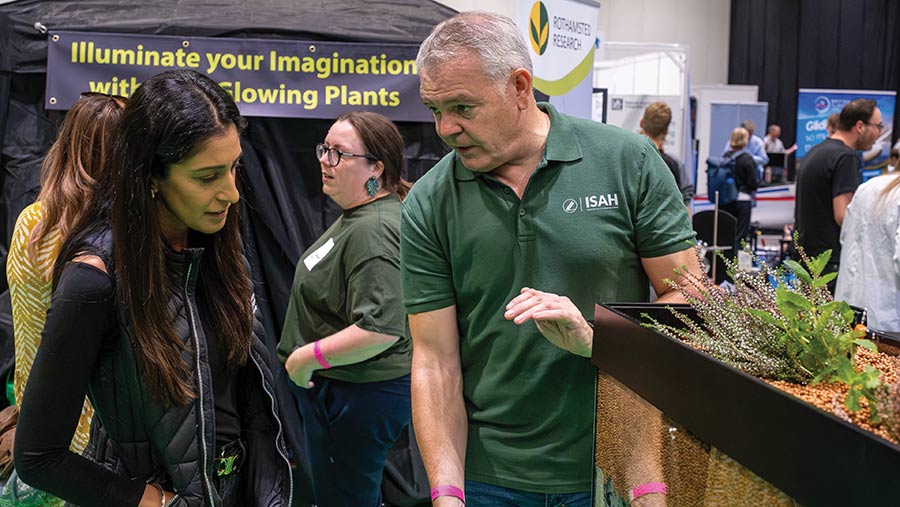New crop irrigation system recycles nutrients and water
 Kevin O’Grady from Isah © Dan Corns/thirdlensfilms.com
Kevin O’Grady from Isah © Dan Corns/thirdlensfilms.com UK trials of a novel irrigation system which collects, stores and recycles water, and reuses nutrients to enhance crop production, are taking place at Writtle University in Essex.
The Irrigation Solar Attenuation Harvest (Isah) system captures rainwater in underground tanks for irrigation or as a flood alleviation tool.
See also: Research targets pheromones to control key arable pests
Since its launch last year, it has been gaining interest in arid countries from Saudi Arabia to Malaysia and Botswana.
Visitors to the New Scientist Live event in London (7-9 October) were able to view a cross-section of a crop field kitted out with the system, and see how agri-tech sensors controlled the water movement as a live data stream showed fluctuating soil moisture levels.
How it works
A soil stabilisation material forms a hydrophobic underground storage base on which attenuation crates are stacked. Each crate has a 95% water storage capacity.
A membrane filter captures nutrients leached from the topsoil, and a simple irrigation pump resupplies these, along with water, to crops as required.
Using specialist remote sensors, operators can control the correct moisture level for crops – particularly in the horticultural industry – to optimise yields.
By capturing rainwater in attenuation tanks under crop fields, and using it for crop irrigation or releasing it slowly back into rivers, the risk of drought and flooding is reduced.
“We see the system working as part of a collaborative approach between farmers, landowners and government agencies,” says founder of the UK system Kevin O’Grady.
Trial system
The Isah trial taking place at Writtle University covers a 10x5m area, with crates buried 0.5m deep in the ground under crops of open-field tomatoes and runner beans.
“For growers who irrigate their crops, just 10-15% of water applied is used by the crop – the remainder is left to drain through the groundwater supply, before returning to the water authorities. But with the attenuation system this water is collected for reuse,” explains Kevin.
A system of 60 attenuation crates, stacked 400mm high, is capable of storing 11,500 litres of water and can withstand up to 62t/sq m of weight above. The system can be placed deeper in the ground – such as 1m – with sites as large as a football pitch.
Installing the system from scratch at Writtle University – including levelling off the site and implementing a cloud monitoring system – amounted to a total cost of £70,000. It has a predicted lifespan of 60 years.
Isah uses a stabilisation material called Envirocore that reacts with clay particles in the soil via a bio-geochemical process to create a solid, impermeable base.
The material is manufactured in Liverpool and has been used in the construction industry round the world for more than 40 years.
“Once the site is level, the topsoil placed to one side and Envirocore rotovated into the ground and compacted, it forms a long-term waterproof barrier which stores water,” says Kevin.
Next steps
The firm is currently applying for UKRI funding in collaboration with Cardiff University for the development of a potential second UK attenuation storage system.
“The technology has come a long way from our launch last year and we are rapidly gaining interest in the UK and round the world.
“Water use efficiency is becoming a more and more important topic, and this tech could be game-changing in developing countries. It’s important we continue to research and develop the system and capture data.”
Furthermore, says Kevin, the novel technology has potential for “3D” solar panel stacking.
“With the solid Envirocore base, solar panels can be bolted to the foundations to capture sunlight above the crops, while still allowing enough sunlight to power crop growth. The system could ultimately provide water storage, food production and energy capture,” he says.
The Future of Food & Agriculture: Feeding the world sustainably – meet the team


Farmers Weekly is working with these organisations to bring the Future of Food & Agriculture exhibit to New Scientist Live.
Partners
Harper Adams University is our lead education partner


